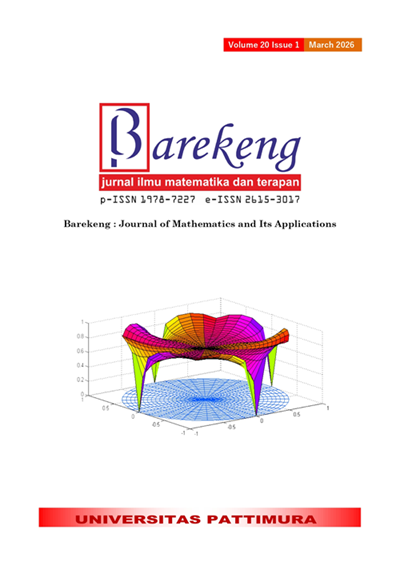COMPARISON OF COPULA FAMILY (GAUSSIAN, ARCHIMEDEAN, AND REGRESSION) IN A CASE STUDY OF COMPOSITE STOCK PRICE INDEX ON INDONESIA STOCK EXCHANGE
Abstract
Stocks are one of the most popular financial market instruments. On the other hand, stocks are an investment instrument that is widely chosen by investors because stocks are able to provide attractive profit levels. Investment is an effort to postpone consumption in the present. Comparing copula families is crucial for selecting the model that best fits the observed data dependency structure. This helps produce more accurate analysis and more meaningful interpretations. This study analyzes different types of copula relationships using the Tau Kendall method, applying it to the movement of the Composite Stock Price Index (IHSG) on the Indonesia Stock Exchange (IDX). The data used are secondary monthly data of IHSG as a response variable, while the explanatory variables are inflation (%), exchange rate (Rp/USD), and interest rate (%) in 2010-2014. The results show the pattern of the relationship between IHSG and its macroeconomic factors on the IDX using copula parameter estimation with the Tau Kendall approach, with the largest log-likelihood fitting results showing a relationship pattern following the Gumbel copula, namely IHSG with inflation, interest rates with IHSG following the Clayton copula, and exchange rates following the Frank copula. Meanwhile, using the regression copula has better interpretation results compared to the Gaussian and Archimedean copula, with an MAPE value of 0.122 with a correlation of 70.63%.
Downloads
References
U. G. Mada and U. I. Indonesia, “CONDITIONAL EXPECTATION FORMULA OF COPULAS FOR HIGHER DIMENSIONS AND ITS APPLICATION,” J. Math. Comput. Sci., vol. 11, no. 4, pp. 4877–4904, 2021. doi: https://doi.org/10.28919/jmcs/5932.
S. Winarni, S. W. Indratno, and K. N. Sari, “PEMODELAN GAMBAR MENGGUNAKAN COPULA GAUSSIAN DENGAN METODE PARTISI,” Stat. J. Theor. Stat. Its Appl., vol. 21, no. 1, pp. 37–43, 2021. doi: https://doi.org/10.29313/jstat.v21i1.7860.
K. N. ‘Anisa,’ “ANALISIS HUBUNGAN CURAH HUJAN DAN INDIKATOR EL-NINO SOUTHERN OSCILLATION DI SENTRA PRODUKSI PADI JAWA TIMUR DENGAN PENDEKATAN COPULA,” vol. 4, no. 1, p. 146, 2015, [Online]. Available: http://repository.its.ac.id/51953/%0Ahttps://ejurnal.its.ac.id/index.php/sains_seni/article/view/8866
B. Sartono and A. Hamim Wigena, “INDONESIA STOCK EXCHANGE COMPOSITE MODELLING WITH GAUSSIAN COPULA MARGINAL REGRESSION,” Int. J. Eng. Manag. Res., no. 4, pp. 311–314, 2016, [Online]. Available: www.bi.go.id
N. Klein, M. S. Smith, D. Nott, and R. Chisholm, “REGRESSION COPULAS FOR MULTIVARIATE RESPONSES,” vol. 2, 2024, [Online]. Available: http://arxiv.org/abs/2401.11804
E. Manik, PENGANTAR PASAR MODAL ( KONSEP DAN PRAKTIK ). Widina Media Utama Dilarang, 2024.
R. E. Caraka, H. Yasin, W. Sugiarto, K. M. Ismail, and R. I. Province, “TIME SERIES ANALYSIS USING COPULA GAUSS AND AR(1)-N.GARCH(1,1),” vol. 9, no. 1, pp. 1–13, 2016. doi: https://doi.org/10.14710/medstat.9.1.1-13.
G. A. Saputri, A. Suharsono, and H. Haryono, “ANALISIS VALUE AT RISK (VAR) PADA INVESTASI SAHAM BLUE CHIPS DENGAN PENDEKATAN COPULA,” J. Sains dan Seni ITS, vol. 8, no. 2, 2020. doi: https://doi.org/10.12962/j23373520.v8i2.46472.
A. Kristiana and Y. Purwono, “MODEL BERBASIS COPULA UNTUK ESTIMASI KERUGIAN AGREGAT DALAM ASURANSI KECELAKAAN LALU LINTAS,” vol. 4, pp. 692–707, 2022. doi: https://doi.org/10.31539/jomb.v4i1.3681
J. Größer and O. Okhrin, “COPULAE: AN OVERVIEW AND RECENT DEVELOPMENTS,” Wiley Interdiscip. Rev. Comput. Stat., vol. 14, no. 3, pp. 1–22, 2021. doi: https://doi.org/10.1002/wics.1557.
C. Sempi, PRINCIPLES of COPULA THEORY. CRC Press Taylor & Francis Group, 2016.
P. R. Dewick and S. Liu, “COPULA MODELLING TO ANALYSE FINANCIAL DATA,” J. Risk Financ. Manag., vol. 15, no. 3, 2022. doi: https://doi.org/10.3390/jrfm15030104.
H. Ullah, M. Akbar, and F. Khan, “DROUGHTS’ PROJECTIONS IN HOMOGENEOUS CLIMATIC REGIONS USING STANDARDIZED PRECIPITATION INDEX IN PAKISTAN,” Theor. Appl. Climatol., vol. 140, no. 1–2, pp. 787–803, 2020. doi: https://doi.org/10.1007/s00704-020-03109-3.
D. Barro, M. Diallo, and R. G. Bagré, “SPATIAL TAIL DEPENDENCE AND SURVIVAL STABILITY IN A CLASS OF ARCHIMEDEAN COPULAS,” Int. J. Math. Math. Sci., vol. 2016, 2016. doi: https://doi.org/10.1155/2016/8927248.
M. M. Marchione and F. Baione, “NON-MONOTONE DEPENDENCE MODELING WITH COPULAS: AN APPLICATION TO THE VOLUME-RETURN RELATIONSHIP,” 2024, [Online]. Available: http://arxiv.org/abs/2403.15862. doi: https://doi.org/10.2139/ssrn.4840395
H. Li, “TAIL DEPENDENCE OF MULTIVARIATE PARETO DISTRIBUTIONS,” arXiv, pp. 1–18, 2006.
F. Benali et al., “MTCOPULA : SYNTHETIC COMPLEX DATA GENERATION USING COPULA,” 2021, [Online]. Available: http://arxiv.org/abs/2403.15862
A. K. Nikoloulopoulos, “EFFICIENT ESTIMATION OF HIGH-DIMENSIONAL MULTIVARIATE NORMAL COPULA MODELS WITH DISCRETE SPATIAL RESPONSES,” Stoch. Environ. Res. Risk Assess., vol. 30, no. 2, pp. 493–505, 2016. doi: https://doi.org/10.1007/s00477-015-1060-2.
K. Joo, J. Y. Shin, and J. H. Heo, “MODIFIED MAXIMUM PSEUDO LIKELIHOOD METHOD OF COPULA PARAMETER ESTIMATION FOR SKEWED HYDROMETEOROLOGICAL DATA,” Water (Switzerland), vol. 12, no. 4, 2020. doi: https://doi.org/10.3390/w12041182.
A. Ali, A. K. Pathak, and M. Arshad, “PARAMETRIC AND SEMIPARAMETRIC APPROACHES FOR COPULA-BASED REGRESSION ESTIMATION,” Hacettepe J. Math. Stat., vol. 53, no. 4, pp. 1141–1157, 2024. doi: https://doi.org/10.15672/hujms.1359072
Copyright (c) 2025 Darwis Darwis, Bagus Sartono, Leny Yuliani

This work is licensed under a Creative Commons Attribution-ShareAlike 4.0 International License.
Authors who publish with this Journal agree to the following terms:
- Author retain copyright and grant the journal right of first publication with the work simultaneously licensed under a creative commons attribution license that allow others to share the work within an acknowledgement of the work’s authorship and initial publication of this journal.
- Authors are able to enter into separate, additional contractual arrangement for the non-exclusive distribution of the journal’s published version of the work (e.g. acknowledgement of its initial publication in this journal).
- Authors are permitted and encouraged to post their work online (e.g. in institutional repositories or on their websites) prior to and during the submission process, as it can lead to productive exchanges, as well as earlier and greater citation of published works.






1.gif)



